Warning: strlen() expects parameter 1 to be string, array given in /home2/orbman69/public_html/wp-includes/functions.php on line 262
(Last Updated On: )
THINK ABOUTIT SIGHTINGS REPORT
Date: December 26, 1980
Sighting Time:
Day/Night: Night
Location: Rendlesham Forest, United Kingdom
Urban or Rural:
Hynek Classification: NL (Nocturnal Light) Point or extended luminous source observed at night.
Duration:
No. of Object(s):
Size of Object(s):
Distance to Object(s):
Shape of Object(s): Triangle
Color of Object(s):
Number of Witnesses: Multiple
Source: Jenny Randles
Summary: What is widely considered Britain’s most extraordinary encounter took place between 26 and 28 December 1980. It involved at least a dozen civilians from villages surrounding Rendlesham Forest, a large pine wood in south east Suffolk eight miles from the large town of Ipswich. However, it also gained a high profile because of its military witnesses, part of a huge USAF contingent at the twin bases of RAF Bentwaters and Woodbridge located beside the forest.
Full Report
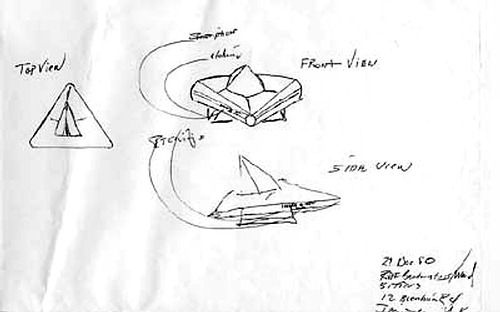
Sketch of the craft, taken from Jim Penniston’s official United States Air Force witness statement.
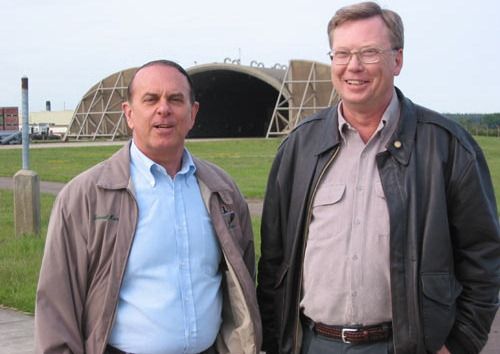
Rendlesham witnesses Technical Sergeant Jim Penniston (right) (USAF-Ret., Woodbridge security supervisor), and (left) Colonel Charles Halt (USAF-Ret., former deputy base commander of Bentwaters-Woodbridge).
What is widely considered Britain’s most extraordinary encounter took place between 26 and 28 December l980. It involved at least a dozen civilians from villages surrounding Rendlesham Forest, a large pine wood in south east Suffolk eight miles from the large town of Ipswich. However, it also gained a high profile because of its military witnesses, part of a huge USAF contingent at the twin bases of RAF Bentwaters and Woodbridge located beside the forest. These had been on long-term lease from the British Ministry of Defence (MoD) since World War Two.
Although the twin bases closed with the cessation of the cold war, other local facilities survive in this high security area. At RAF Bawdsey the world’s first working radar was developed. And Orford Ness, a coastal spit five miles from the Woodbridge base, was for many years a secret research facility. “Over The Horizon” beam experiments (code named Cobra Mist) led to warnings that shipping coming too close to the shore might experience “interference”.
The area surrounding the forest has long been a hotbed of UFO activity, with fishermen reporting strange blisters on their skins and the sightings of green fireballs emerging from the North Sea around the Ness.
Then, at approximately 3:00 a.m. on 26 December l980, a two-man USAF security patrol near the East Gate of RAF Woodbridge observed strange coloured lights above the forest in the direction of Orford Ness. Assistance was requested and a security unit was sent out from Bentwaters. The lights were now deep inside the pine wood and three men, Sergeant Jim Penniston, his driver, Airman Ed Cabansag, and one of the two original security officers, airman (later sargeant) John Burroughs, drove down a logging track that led into the forest, proceeding the rest of the way on foot owing to the frozen terrain.
All three men closed in on an object that resembled an “aircraft on fire”, or, as Burroughs described it, a “multiple series of lights”. At closer proximity, the lights solidified. Burroughs says that no structured craft ever emerged, but Penniston claimed that he went close enough to see an actual object looming from within the glow that was “the size of a tank…It had a very smooth surface almost like glass”. Cabansag, whilst more guarded, agrees that strange lights were visible.
At close proximity Penniston says “The air was filled with electricity – like static.You could feel it on your skin as you approached the object. There was also a sense of slowness, like time itself was an effort.”
Burroughs concurred: “The nearer we got to that thing the more uneasy I felt…it was as if I was moving in slow motion. I felt really hot and as if the hair was standing up on the back of my head”.
There was then a silent explosion of light, causing the airmen to throw themselves to the ground in a defence. The object disappeared towards the coast and “was gone like a blur”. However, the three men began to follow a light that had appeared in the distance. Only after pursuing this for some minutes through the forest did they discover that they were chasing the glow from the lighthouse situated on Orford Ness. They do not believe this was what they had witnessed earlier at close quarters.
After discovering “marks” on the forest floor the airmen returned to base to be debriefed. British civilian police sent two officers to the forest and senior policeman, David King, met with Colonel Ted Conrad on the logging road at 4:11 a.m. From here they reported seeing only the Orford Ness lighthouse; although the UFO had long since disappeared.
At 10:30 a.m. police were called to the woods again to study the holes now confirmed as located in the ground at the landing site and forming a roughly triangular pattern. In the log report at the Woodbridge police station these were noted as possibly having been caused by animals.
The Suffolk police established that there were several UFO reports during the previous night, including sightings on radar screens at Heathrow Airport near London. It is likely that much of this activity referred to an incident just after 9:00 p.m. on 25 December, when the booster from a Soviet space probe had burned up on re-entry over South East England and fell into the North Sea. This trail of debris brought a flood of sightings into BUFORA (the British UFO Research Association) as well as to the Civil Aviation Authority (CAA), because some witnesses thought that this was an aircraft exploding in mid-air.
Local UFOlogists, Brenda Butler and Dot Street, later found many witnesses in surrounding villages to the lights that Burroughs had reported over the forest. The Webb family, returning from a Boxing Night party on the road through the forest, observed floating lights and had time to slow their car to a stop, eliminating one theory since proposed for this UFO: a short duration meteor that astronomers had witnessed in the sky around this time.
The sighting by the USAF patrol quickly became the talk of the base, and next day (27 December) strange lights were reported again by airmen who were having an unofficial “sky watch” in the forest. Concerned about morale base security chief, Lieutenant Bruce Englund, interrupted an officers Christmas party on Woodbridge base to report the new sightings.
Base commander, Colonel Ted Conrad, who had an awards speech to give at the party, ordered his deputy, Lt Colonel Charles Halt to gather a team and sort out the matter once and for all. Halt duly collected a tape machine to take notes in the dark woods , and took a small group of men, including Englund, an officer from the disaster preparedness team and a base photographer, to prepare for a nocturnal investigation. Gas-powered “lightall” searchlights were taken with them, but these constantly malfunctioned near to the “suspected landing site”.
Halt and his team were in the forest from soon after midnight early on 28 December through to just before dawn. During this time they took samples of soil and damaged tree bark, photographed the landing marks, measured a hole in the tree canopy at the point where Burroughs, Penniston and Cabansag had seen the UFO depart 48 hours earlier and used geiger counters to take readings that they considered to be unusual radiation levels within the impact marks.
Halt intermittently recorded the team’s progress onto the tape, until at 1:48 a.m. some airmen in the party reported strange activity. This tape runs for 18 minutes and was released to British UFO investigators in July l984 by a US Major, who had held a copy for four years. On this dramatic audio account of the early hours of 28 December you can hear the following exchange:
Halt: Zero one forty eight, we’re hearing very strange sounds out of a farmer’s barnyard animals…very, very active, making an awful lot of noise.
Airman: There…look.…
Halt: You just saw a light? Where? Slow down…where?
The witnesses debate this pulsing light, and at one point (after viewing it through an optical enhancer known as a starlight scope) it seems to break apart; possibly an effect of an optical distortion. They then set off to follow the glow, much as the three airmen did at this same position two nights earlier, when misperceiving the Orford Ness lighthouse.
Halt: We are about 150 to 200 yards from the site. Everything else is just deathly calm. There’s no doubt about it, there’s some type of strange flashing red light ahead.
Airman: Sir, it’s yellow.
Halt: I saw a yellow tinge in it, too…Weird! … it appears to be moving a little bit this way…It’s brighter than it has been. It’s definitely coming this way…Pieces of it are shooting off…There’s no doubt about it this is weird.
Further sightings continued, mostly of small star-like lights, moving in box-grid patterns and scattered about the sky. It seems hard to deny that some of these could be stars caused to move by the effects of autokinesis (an optical illusion), the clear night sky and the effects of wind. But at one point another very strange event does occur as Halt and his men report pencil-thin beams of light coming from the sky.
Halt (In clearly stunned tones): Now we observe what appears to be a beam coming down towards the ground…this is unreal.
Halt has since explained that this was like a laser and it struck the ground only feet from the men but also beamed into the weapons storage area back on base, where, unbeknownst to British citizens, nuclear weapons were then located.
With his men now tired, Halt ordered them to return to base. As the sky lightened he saw one more “UFO” still hovering over the woods, but this faded as the sun came up; behaviour that almost certainly proves this one to be a star; although it is much harder to account for the laser beam.
Again, there were civilian witnesses to events on this second night. These included local villagers familiar with Orford Ness and far less likely to be fooled by a lighthouse than would foreign airmen unused to these woods at night. Sarah Richardson, for example, observing from her bedroom in Woodbridge, saw: “three bands of star like light and they were bright, coloured red, blue and yellow.”
After taking statements from the witnesses and plaster casts of the landing marks, there was confusion on base as to what to do next. It was technically a British matter, but the Suffolk constabulary had shown no interest in the story. However, the MoD needed to be informed.
On 13 January l981 Colonel Halt officially reported the matter to London at the request of Squadron Leader Donald Moreland, who acted as liaison between the landlord MoD and their USAF tennants. Although Moreland personally saw nothing, he had every confidence in the men who did and sent a note fully endorsing Halt’s memo to the MoD.
Neither Halt nor Moreland received any further contact from the British government. This memo was just a one-page summary of the events. It made no reference to the fact that soil samples, plaster casts, photographs and other evidence from the landing site had been taken, nor that a “live” audio tape existed of the second night’s sightings. Halt says that he would have made this data available had the MoD chosen to follow up the case, but they never bothered to do so.
Unfortunately, the chronology on the memo is also misleading. It was apparently put together from memory three weeks after the events.
This memo was eventually secured, using the Freedom of Information Act, by US group CAUS in June l983; this being two months after the MoD had finally written to myself and officially accepted that an unsolved incident had occurred. In this startling letter they confirm “unidentified lights” had been seen and that “no explanation was forthcoming”—an unprecedented admission by British standards.
We now know that the inaccuracy in these dates misled the British government. Whilst files regarding Rendlesham Forest were sealed from public release until 2014, in an unexpected move, following requests by folklore researcher, Dr David Clarke, the MoD agreed to release the entire case file in summer 2001.
This 150-page file paints a picture of an MoD department baffled by the events and unable to explain them, but not taking any urgent action. Although they were aware of reports of allegedly high radiation readings they merely sent letters to various government departments asking for advice and then waited weeks to get responses despite continued puzzlement from experts. Yet whilst the case was still secret, villagers in eastern Suffolk were walking dogs and picnicking freely around a forest that might have been irradiated!
It is likely that the recorded radiation levels were not dangerous, but the complacency whereby that fact was assumed certainly was potentially disasterous.
The MoD file reveals no evidence that the British government believed this case to be solved, but still regarded it as having no defence significance. The lack of any unidentified radar targets that correlated with the UFO sightings was one key reason. However, the communications between the MoD and “Eastern Radar” (RAF Watton) included with the file offer two caveats. The RAF radar was not apparently working fully at the time. More seriously, the radar coverage on the night of 26/27 December was the data being pursued when we know that the first sighting had really occurred 24 hours earlier.
Opinion within UFOlogy is seriously divided as to what really happened inside Rendlesham Forest on those two winters nights. Some researchers feel it is one of the strongest examples of a military encounter with a possibly alien craft, and the sincerity of the many independent witnesses is not in dispute.
However, it seems likely that a number of factors combined to explain parts of this case—particularly on the second night (28 December) when stars and the lighthouse do seem to have been mistaken during phases of this lengthy encounter. The lighthouse is an unexpected sight, so far inland, particularly to those not familiar with these woods at night or the effects of the undulating landscape.
Other considerations include the presence of sea mist, during the first sighting particularly, and the possibility of mirage effects; plus, of course, the covert research known to have occurred for decades in the vicinity of Orford Ness.
The radiation levels seem not to have induced any lasting ill effects and experts studying the records suggest that they were not abnormally high for within a pine forest, especially one close to a nuclear power station.
On the other hand, there are aspects to this case very difficult to explain, particularly the alleged physiological effects and distortions in time and space reported by Burroughs and Penniston in close proximity to the 26 December UFO. And, of course, the “laser beams” witnessed by Halt 48 hours later.
This case is certain to remain the source of many arguments for years to come and has already generated more books discussing the evidence than any other single case apart from Roswell.
More Articles on this Case
The Rendlesham Files Reviewed
Nick Pope, UFO Magazine, Oct. 2001
“Ever since Georgina Bruni first broke the story concerning the release of MOD documents on the Rendlesham Forest incident, I’ve found myself on the receiving end of numerous questions concerning the papers. [Here are] observations based on my personal involvement with this case.”
Rendlesham Unravelled – The ‘Halt Tape
James Easton
This is a new transcript of the tape recording made by Lieutenant-Colonel Halt, subsequently Colonel Halt, during the second night’s events, when he set out to investigate claims that the ‘UFO’ was back.
THE RENDLESHAM FOREST UFO CASE
by Ian Ridpath
Note: This article about my investigation of the Rendlesham Forest UFO case first appeared in The Guardian on 1985 January 5, and is given here in slightly amended form. The article was written before the release of the tape-recording made by Lt.Colonel Charles Halt during the events of the second night, when he participated in the sightings.

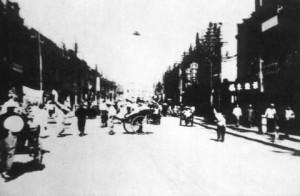
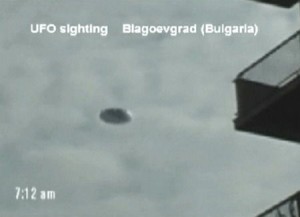
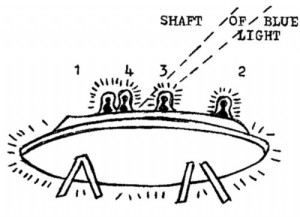
Related Reports
Warning: strlen() expects parameter 1 to be string, array given in /home2/orbman69/public_html/wp-includes/functions.php on line 262
9 min read
1980: An Analysis of the Rendelsham Forest Telepathic Binary Sequence – Article